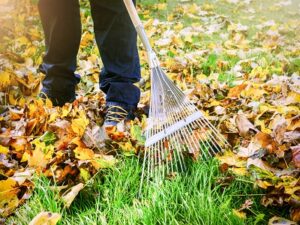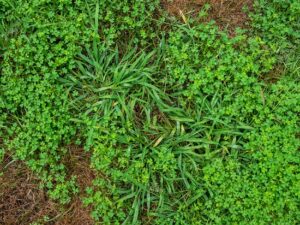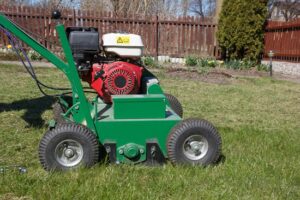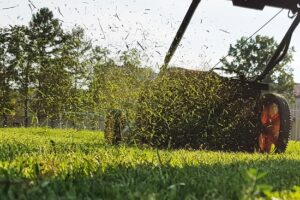- Fall lawn care in Carolina Forest depends on whether you have a warm-season or cool-season grass. More than likely in the Myrtle Beach area you will find a warm-season grass such as Bermuda or Saint Augustine.
- Those lawns with warm-season grass who want to have green grass in the colder months need to apply a winter annual rye. This grass will grow and be green during the cold months and then die off in the warmer months allowing the normal warm-season grass to grow
- Fall is the time to start lowering the level of mowing slightly, this helps build the roots ensuring that the grass will survive the winter months and grow back strong the next season.
- Fall is also time to aerate your lawn to loosen up the soil that has been compacted over the summer months.
- Grubs lay their eggs during July and August, so the fall is the time when grub control is important.
- Fall is also the time of year to pick up the falling leaves. A pile of leaves on a lawn will kill the grass and cause a bare spot.
Conner’s Lawn Care Service can make sure your lawn is ready to survive the colder months by being in the healthiest condition possible. We will apply any fall fertilizers, bug control, aerate your lawn along with our normal lawn maintenance services of mowing, trimming and weed eating. If you decide that you want to have a green lawn year-round, we can help your lawn stay green and maintained no matter the season.
Like our Facebook page for more great info about lawn maintenance.
Discover more lawn care tips when you call Conner’s Lawn Care.
Conner’s Lawn Care Service
Myrtle Beach, SC
843-504-4901
http://connerslawncare.com/


 You all know that summer is not complete without hot and dry days. Many lawns seem to be prone to burning in the heat. You’ll find a few lawns in your neighborhood that are greener than others. Here are four
You all know that summer is not complete without hot and dry days. Many lawns seem to be prone to burning in the heat. You’ll find a few lawns in your neighborhood that are greener than others. Here are four  Do you have crabgrass on your lawn? It’s not uncommon. This unsightly weed is pervasive and could be taking over your yard right now. Here are some
Do you have crabgrass on your lawn? It’s not uncommon. This unsightly weed is pervasive and could be taking over your yard right now. Here are some  It may be time to aerate your lawn if your lawn shows signs of wear and water isn’t reaching the surface. Here are some
It may be time to aerate your lawn if your lawn shows signs of wear and water isn’t reaching the surface. Here are some  Listed below are some common questions about
Listed below are some common questions about  If your lawn isn’t looking its best, you might think about applying fertilizer. Although this instinct is not always correct, it’s important to remember that details are everything when it comes to
If your lawn isn’t looking its best, you might think about applying fertilizer. Although this instinct is not always correct, it’s important to remember that details are everything when it comes to  Mowing your lawn is one of the most time-consuming
Mowing your lawn is one of the most time-consuming  You should include fertilizing your lawn in your annual
You should include fertilizing your lawn in your annual  How often you fertilize your lawn depends on its type, ingredients, quantity, soil texture, nutrient levels and many other factors. You need to consider all factors when deciding when to fertilize your lawn as part of your
How often you fertilize your lawn depends on its type, ingredients, quantity, soil texture, nutrient levels and many other factors. You need to consider all factors when deciding when to fertilize your lawn as part of your